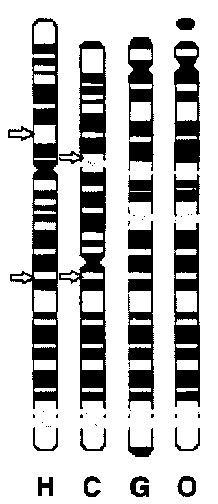 |
Science Frontiers ONLINE No. 122: Mar-Apr 1999 |
|
|
A Genetic Disconnect
 Bandings on chromosome 9 from humans (H), chimpanzees (C), gorillas (G), orang-utans (O) |
If human and chimpanzee nuclear DNAs differ by only 1.5%, why are the two species so profoundly different in anatomy and behavior?
The obvious external differences are body hair, the use of language, the method of locomotion, and of course culture. Less well known is the fact that humans are more susceptible to diseases like as cancer and AIDS.
Apparently, superficial comparisons of DNAs slough over genetic details that result in major differences in the living animals.
Some of the genetic differences between humans and chimps seem to belie that miniscule 1.5% difference everyone bandies about. To illustrate, humans have only 46 chromosomes, while the great apes all have 48. The 1.5% figure doesn't hint at this significant difference. Next, take a look at chromosome #9 in humans and the great apes. Chromosome bandings are different enough to raise further suspicions about the 1.5% figure.
(Gibbons, Ann; "Which of Our Genes Make Us Human?" Science, 281:1432, 1998.)
Comments. It is easy to see how gross comparisons of DNA might miss important details. The popular "DNA-hybridization" method simply mixes together strands of DNA from the two species being compared. These are allowed to combine, and then they are heated to see how much temperature is required to force them apart. Chromosome numbers and bandings have little if any effect on these crude comparisons of the bare DNA strands that have been stripped from their genes and chromosomes.
The significance of all this transcends the comparisons of humans and chimps. Modern taxonomy of all life forms depends increasingly upon DNA comparisons rather than upon morphology. If DNA comparisons can be as misleading as they are in humans and chimps, those textbook family trees that are supposed to tell us how life evolved may also be giving us an erroneous history of life.
To underscore the problem, sometimes DNA genetic differences do not result in big morphological changes. For example, Three-toed Woodpeckers hammer on trees all over the northern reaches of North America and Eurasia. These birds all look alike and interbreed freely. Yet, some of the birds differ so much genetically that they should be classified as different species on that basis. (See BBG1 in Biological Anomalies: Birds.)